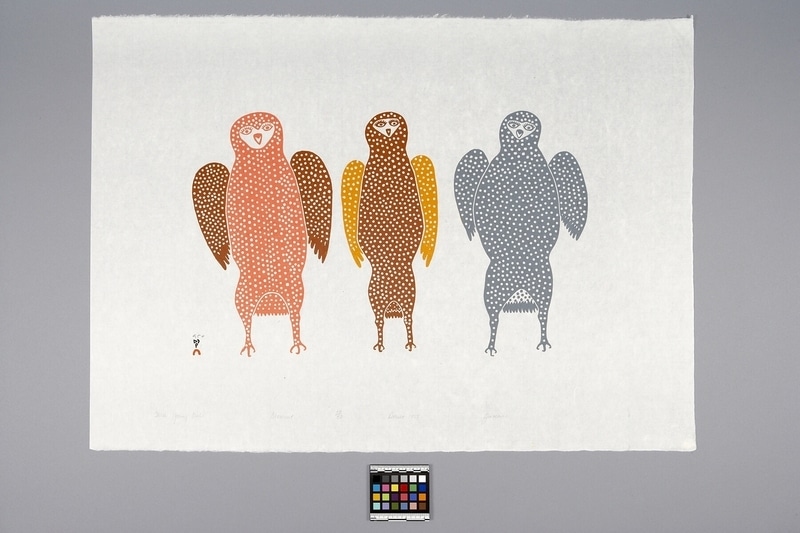Three Young Owls Item Number: Na806 from the MOA: University of British Columbia

Description
Print depicting three front-facing young owls with their wings slightly raised: from left to right, the first owl has an orange-pink body with brown wings, the second has a brown body with dark orange-yellow wings, and the last owl is grey overall. Each owl figure has an overall white dot pattern, and their faces are white with eyes and beaks the same colours as their bodies. Below the image is written, "Three Young Owls 39/50 Dorset 1975 Jamasie." The name of the artist is written above that of the printmaker, which is printed in Inuit syllabics along with the Cape Dorset Co-operative red igloo seal in the bottom left-hand corner of the image. The Canadian Eskimo Arts Council blind embossed stamp is in the bottom right-hand corner.
History Of Use
Contemporary Inuit prints were first produced at Cape Dorset in 1957. Although precursors to printmaking can be seen in women's skin applique work and in men's incising of ivory, stone and bone, the impetus for printmaking was as a commercial venture. This venture was established jointly by Inuit artists and John Houston, the civil administrator for Cape Dorset. Other Inuit communities quickly followed the commercial success of Cape Dorset's West Baffin Eskimo Cooperative. Printmaking developed as a communal activity following a Japanese, rather than a Western, model of serigraph production. Each year the cooperatives produce a series of limited edition prints which are sold in the retail art market. In 1965, the Canadian Eskimo Arts Council was established from the Canadian Eskimo Art Committee to ensure high standards were maintained. Printmaking, along with stone carving, provide cash income for communities which have undergone rapid and significant change, during the late 20th century, from traditional hunting based societies to settled communities dependent on consumer goods. The prevalent images depicted in Inuit art are of traditional life, arctic animals and mythology. Recently, contemporary subjects have been depicted by a minority of artists.
Narrative
The Dorset Cooperative follows Japanese tradition, where printmaking specialists assume responsibility for the print, rather than the artist supervising all aspects of the process. The earliest prints were stone cut and stencil. Copperplate engraving dominated by the early 1960's, with a continuation of printing. Lithographs were introduced in 1972. Artist followed by printmaker when 2 names are given in the artist/maker field. Cape Dorset catalogue number: 29-75. Image first appeared as monochrome print in 1973. Related stonecut print entitled 'Baby Owls' is in the Canadian Museum of History's collection.
Cultural Context
contemporary art
Item History
- Made by Jamasie Teevee (Maker) and Timothy Ottochie (Technician) in Cape Dorset, Nunavut, Canada and Kinngait, Nunavut, Canada during 1975
- Collected before 1983
- Owned by Guenter Adolphs before December 15, 1983
- Received from Guenter Adolphs (Donor) on December 15, 1983
What
- Name
- Three Young Owls
- Identification Number
- Na806
- Type of Item
- Overall
- height 61.5 cm, width 88.0 cm
- Image
- height 44.0 cm, width 63.0 cm
Who
- Culture
- Inuit
- Creator
- Jamasie Teevee (Maker) and Timothy Ottochie (Technician)
- Previous Owner
- Guenter Adolphs
- Received from
- Guenter Adolphs (Donor)
Where
- Holding Institution
- MOA: University of British Columbia
- Made in
- Cape Dorset, Nunavut, Canada and Kinngait, Nunavut, Canada
When
- Creation Date
- during 1975
- Collection Date
- before 1983
- Ownership Date
- before December 15, 1983
- Acquisition Date
- on December 15, 1983
Other
- Item Classes
- works on paper
- Condition
- good
- Accession Number
- 0914/0076